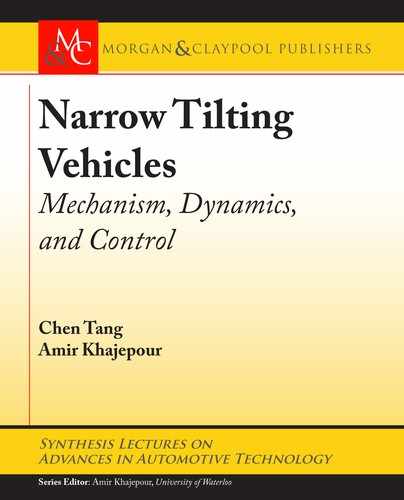
4.7. HOLISTIC ENVELOPE CONTROL: MPC DESIGN EXAMPLE 51
4.7.1 NON-MINIMUM PHASE IN ACTIVE TILTING CONTROL
e non-minimum phase system are known as any dynamical system whose transfer function
has RHS zeros [77]. Before any detailed derivations are given, an intuitive way to look at this is
through the phase plot of the roll envelope introduced in Section 4.3.4.
Previous envelope plots are drawn for cases with small or no disturbances, in which no
control actions are taken. However, when disturbances are estimated to cause rollover dangers,
active tilting control should be applied for rollover mitigation. As shown in Eq. (3.14), the
rollover index is dependent on motion states as well as control inputs. When tilting moment is
applied, the envelope starts to shift instantly as described by the algebraic equation. is could
cause problems, as demonstrated in Figure 4.10.
1
0.5
0
-0.5
-1
1
0.5
0
-0.5
-1
-0.3 -0.2 -0.1 0 0.1 0.2 -0.3 -0.2 -0.1 0 0.1 0.2
dφ (rad/s)
dφ (rad/s)
φ (rad) φ (rad)
(a) Without tilting torque (b) With tilting torque
Figure 4.10: Effects of tilting torque on the roll envelope.
e uncontrolled roll dynamics under high lateral acceleration disturbances is shown in
Figure 4.10a. As before, two sets of LTR boundaries are plotted. Given initial states (denoted by
dots) on the boundary, they will converge to the equilibrium point which is outside the safe enve-
lope. As a comparison, the dynamics with a constant tilting torque is illustrated in Figure 4.10b.
Starting with same initial conditions, the new state trajectories in blue are now converging to
the inner side of the original boundary. is definitely helps the roll stability of NTVs in steady-
state, however, transient performances could be deteriorated due to the boundary shift with the

52 4. TILTING VEHICLE CONTROL
applied torque. e new LTR envelope boundaries considering the effect of tilting moments
are plotted in pink. Since it takes time for roll states to converge to the new equilibrium while
the LTR envelope changes instantly after the torque is applied, the LTR index gets even worse
during the transient phase.
e RHS zero, according to the definition of non-minimum phase systems, can be ex-
plicitly shown by combining Eqs. (3.9) and (3.14). e transfer function from tilting moment
to LTR index is written as
H.s/ D C
r
.
sI A
r
/
1
B
r
C D
r
D
2
.
I
x
s
2
m
s
h
s
g
/
.
m
s
Cm
u
/
T
w
g
.
I
x
s
2
CC
sCK
m
s
h
s
g
/
:
(4.17)
e zeros of the above transfer function can be solved as
s D ˙
p
m
s
h
s
g
=
I
x
; (4.18)
which indicates there always exists an RHS zero. A fundamental limitation between response
time and system overshoot exists according to [78]. Higher tilting moment helps to change
the roll dynamics quicker at the cost of more severe LTR index overshoot. From a physical
perspective, this can be explained by referring to the force analysis in Figure 3.2, as
1. to balance the lateral acceleration .a
y
/ with gravity, a clockwise roll angle in steady state
is desired;
2. the tilting torque applied to the sprung mass needs to be in the clockwise direction, so as
the roll acceleration;
3. treating the sprung and un-sprung mass as a whole, tilting moment as an internal force
does not change the load distribution directly, but the inertia moment due to the roll
acceleration makes the LTR index worse; and
4. the fundamental limitation exists between the steady-state target (achieve desired roll angle
as soon) and the transient objective (small roll accelerations to avoid LTR overshoot).
A quick reaction time is definitely desired for emergent rollover mitigation, while the tran-
sient overshoot should be carefully monitored and bounded in the controller design. To address
this, an optimal controller based on the vehicle roll model is proposed to compromise between
these conflicting targets. e prediction capability in the controller is considered quite beneficial
since it can foresee the arriving of the envelope violation and applies the tilting moment at an
early stage to minimize the overshoot.
..................Content has been hidden....................
You can't read the all page of ebook, please click here login for view all page.
